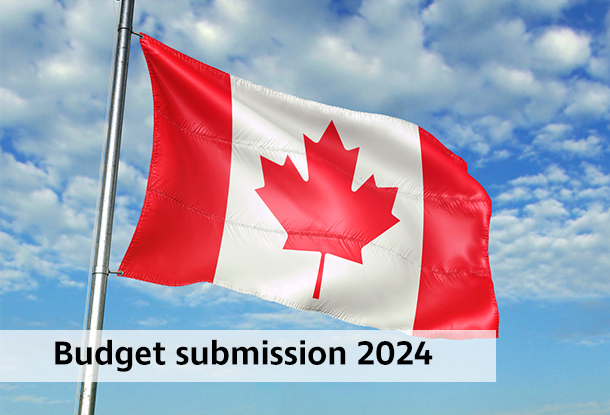New Pathway.
Canada’s 2016 budget was presented in Parliament a couple of weeks ago but it is still featuring in the media headlines as this year’s budgetary policy represents a stark contrast with the previous government’s policies. For a comment on this year’s budget, the New Pathway turned to Borys Wrzesnewskyj, MP (Etobicoke Centre). Mr. Wrzesnewskyj believes that this budget addresses a major structural problem in Canada, that the middle class, if to account for changes in the cost of living, has not improved its standard of living for decades.
Borys Wrzesnewskyj notes that back in the 1950s-1970s, most families could manage and even get ahead financially with only one partner working, while the other could stay at home to raise children. That is no longer a possibility: families might have a slight nominal increase in their standard of living but now both parents have to work to maintain that standard of living. Thus, people have to work as much as double the number of hours for the same standard of living. “Canadians are working harder and not getting ahead,” says Mr. Wrzesnewskyj.
This situation has additional repercussions, says Borys Wrzesnewskyj: “With both partners working, families cannot afford to have as many children if they want to achieve a certain standard of living. We have an aging society with increasing costs of health care and a death rate that exceeds our birth rate. We have to address those fundamental, structural issues.”
Another side to this structural change, says Mr. Wrzesnewskyj, is that there is now a new super rich class in Canada: “Their incomes have skyrocketed and now we have a billionaire class. There is a huge income difference today in Canada compared to what we had only 20 years ago. We did not have this kind of super-rich class here in Canada, like they had in Latin America and to a certain degree in America. And this needs to be addressed.”
To address this inequality, says Borys Wrzesnewskyj, the new government decided to depart from the flat tax system for super rich. Canada has a progressive taxation system for everyone up until the $200,000 a year income bracket, which is roughly 90% of Canadians, or the middle class, notes Mr. Wrzesnewskyj. Beyond that, the tax rate for super rich was flat. And the Liberal government, in accordance to its promises made during the election campaign, has added an additional tax category for this bracket with a 33% tax rate (up from 29%, see the chart).
The Liberal Party also promised to lower the tax on the middle class and dropped the tax rate from 22% to 20.5% for the $45,000-$90,000 bracket. According to Borys Wrzesnewskyj, on average, it translates into $550 per household annually. “Not huge, but not insignificant”, says Borys Wrzesnewskyj.
The other part of the government's initiative to help the middle class is the increase in child tax benefits. Borys Wrzesnewskyj says that Canada had a confusing system of child tax benefits with three different benefits – National Child Benefit, Canadian Child Tax Benefit, Universal Child Care Benefit which Mr. Wrzesnewskyj calls “the worst” because it was paid to everyone making greater than $25,000/year: “If one is making $10 Million a year, they don't need a child benefit cheque.” The government has replaced this system with a single program which provides significantly more to all categories below $150,000 a year and does not provide anything for those who make over $200,000 (see the chart). In addition, child benefits will no longer be taxed. “And our hope is that with time, all these measures will turn things for the better for the middle class and address the previously mentioned demographic problems. Maybe people will go “hmm, perhaps we can afford to have a second child”. Twice during the election campaign, I encountered people in Etobicoke who told me that they had made the emotionally tough decision to not have a second child because they couldn’t afford it, and in both of those cases both parents were working. Now, lower middle class families are going to get $6,400 a year for each kids under the age of 6, and $5,400 for those over the age of 6.”

To fulfill this significant increase in the Child Benefit, some things had to be eliminated, in particular, so called “boutique taxes”. For instance, the Child Fitness Tax Credit is reduced this year and will be eliminated next year. “I was explaining this to a group of parents a couple of days ago and they were very upset because it’s gone”, says Borys Wrzesnewskyj, “and I said, yes, but you should be quite happy because with the new child benefit you can pay for more swimming lessons than before.”
Another initiative that has become a trademark of the new government's policies is the plans to invest in infrastructure. About 1/3 of this investment will go into public transit, which is a pressing issue for Etobicoke, says Borys Wrzesnewskyj. Mr Wrzesnewskyj expects that the infrastructure projects will create about 30,000 qualified construction jobs nationwide: “Investments in infrastructure are investments in the future, and they also are intended to improve the inefficient transit system and save on transportation costs.”
In Etobicoke, there is a plan for the light rail (LRT) line to go from Eglinton to the Mississauga's MiWay system and the Pearson airport. Borys Wrzesnewskyj says that it needs to be ensured that “the money is there to build it, and that it’s built the right way.” He is planning to have meetings in the following months to make sure that the concerns about the LRT line are heard: “First of all, we don’t want the line to run down in the middle of Eglinton. That would cause tremendous disruption – we saw what happened with the streetcar line on St. Clair, or with the earlier line along Spadina – it causes traffic issues with left turns that cross all those transport lines and then you have to build islands in the middle for people – it makes no sense. So, my suggestion is to build it on one side and one line only, two lines is old thinking. What we need is a single line with switch lanes, just like they do with trains. When they built the CPR across the country, they didn’t built two lines, they built a single line and trains could pass each other in switch lanes. In places that have specific challenges, like they do in Amsterdam because of the canals, that’s exactly how they do it – single lanes with switch lanes. That would provide a lot more space and it’s all computerized now. It would also eliminate the safety issues for people standing in the middle of the road on an island, especially on a busy and fast thoroughfare like Eglinton.”
“Another issue for the LRT line along Eglinton is that, unfortunately, some of the lands there were sold by the late mayor Rob Ford. There is now construction going on on those lands. So, there is a portion of the line that, I think, almost inevitably will have to go underground. And 10km out of 16km of the Light Rail along Eglington through the city is underground. So, we might need about 1km of the line in Etobicoke, maybe even less, to go underground.”
“And another problem with the planned LRT line is that some of the plans showed only a couple of stops in Etobicoke. If we build it, we don’t want it strictly as transit across from Mississauga to downtown Toronto, we want it to serve the local neighbourhoods. So we want more stops in Etobicoke Centre. Whether it's kids going to school, a lot of high school kids depend on TTC, or new immigrants in places like along Scarlett Rd. – we would need a stop at Scarlett. Same thing over at Kipling or perhaps on the West Mall. So we need at least two additional stops along that line through Etobicoke.”
We asked Borys Wrzesnewskyj, about the envisaged federal role in financing of the LRT line. Mr. Wrzesnewskyj said that the federal government made it clear that these kinds of projects are constitutionally within the jurisdiction of the provinces and municipalities. “But a big chunk of the money will come from the federal government. It has no strings attached. However, it is the same electorate. It’s not the three different people that vote municipally, provincially and federally, and when it’s a concern of my electorate, it’s a concern of mine and when I speak, I speak on behalf of the people of Etobicoke Centre. I intend to be heard and that's why I have arranged meetings at City Hall, a meeting that is coming up with the provincial Minister of Transport, and I want to make sure that they hear this message.”
Summing up the initiatives in the 2016 Budget, Borys Wrzesnewskyj said: “This Budget shows that the promises we made during the election weren’t just political promises. We are acting on delivering one of the most important shifts in Canada's tax policy in decades, probably on a similar scale to the introduction of the GST. And the infrastructure investment will also become a major change that will help lift our economy.”
Share on Social Media




































